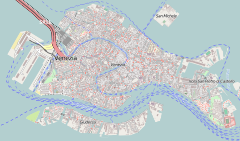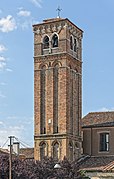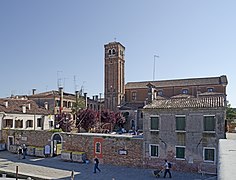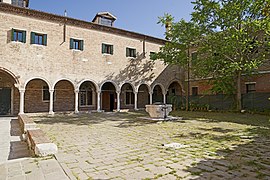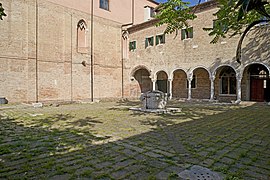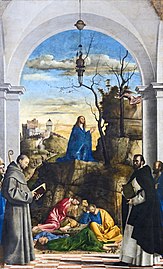History
The church is dedicated to Saint Job. It is one of the five votive churches built in Venice after an onset of plague. [1]
In 1378 a hospice with a small oratory dedicated to San Giobbe or Saint Job attached was begun on this site by Giovanni Contarini, on land he owned near his house. It was completed by his daughter Lucia, with the help of the Minor Observant Friars. The oratory was replaced by the present church by Bernardino of Siena, with the financial backing of doge Cristoforo Moro in gratitude for Bernardino's prophecy that Moro would become doge - Cristoforo donated 10,000 ducats to the building works in 1471, three months before his death, and was buried in the church. Work began in 1450, paused until 1470, and was finally consecrated in 1493, as one of the first examples of Renaissance architecture in the city. It was begun by Antonio Gambello and (when work began again in 1470) completed by the sculptor and architect Pietro Lombardo, with the latter designing the present altar arch and main door as well as much of the interior decoration.
It contains the tomb of René de Voyer de Paulmy d'Argenson, French ambassador to the Republic of Venice, by the French sculptors Claude Perreau and Thomas Blanchet. Its altarpieces house works by Vivarini, Pietro Lombardo, Luca Della Robbia, Basaiti and Bordone, as well as Girolamo Savoldo's Il Presepio (1540). The church also formerly held Giovanni Bellini's San Giobbe Altarpiece and Vittore Carpaccio's The Presentation of Jesus in the Temple: these works are now in the Gallerie dell'Accademia.

Giovanni Bellini was an Italian Renaissance painter, probably the best known of the Bellini family of Venetian painters. He was raised in the household of Jacopo Bellini, formerly thought to have been his father, but now that familial generational relationship is questioned. An older brother, Gentile Bellini was more highly regarded than Giovanni during his lifetime, but the reverse is true today. His brother-in-law was Andrea Mantegna.

Cannaregio is the northernmost of the six historic sestieri of Venice. It is the second largest sestiere by land area and the largest by population, with 13,169 people as of 2007.
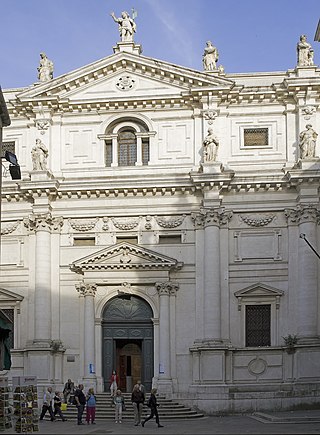
The Chiesa di San Salvatore is a church in Venice, northern Italy. Known in Venetian as San Salvador, is located on the Campo San Salvador, along the Merceria, the main shopping street of Venice. The church was first consecrated in 1177 by Pope Alexander III shortly after his reconciliation with Emperor Frederick Barbarossa at nearby San Marco. The present church, however, was begun in around 1508 by Giorgio Spavento and continued after his death the following year by Tullio Lombardo, Vincenzo Scamozzi and possibly Jacopo Sansovino. They built a large hall church, formed from three Greek crosses placed end to end. Each has a dome with a lantern to let light into the cavernous interior. The facade was added in 1663 by Giuseppe Sardi.
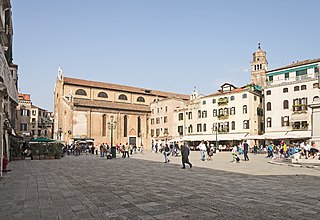
The Chiesa di Santo Stefano is a large Roman Catholic church at the northern end of the Campo Santo Stefano in the sestiere of San Marco, Venice, Italy.

Vittore Carpaccio (UK: /kɑːrˈpætʃ oʊ/, US: /-ˈpɑːtʃ-/, Italian: [vitˈtoːre karˈpattʃo]; was an Italian painter of the Venetian school who studied under Gentile Bellini. Carpaccio was largely influenced by the style of the early Italian Renaissance painter Antonello da Messina, as well as Early Netherlandish painting. Although often compared to his mentor Gentile Bellini, Vittore Carpaccio's command of perspective, precise attention to architectural detail, themes of death, and use of bold color differentiated him from other Italian Renaissance artists. Many of his works display the religious themes and cross-cultural elements of art at the time; his portrayal of Saint Augustine in His Study from 1502, reflects the popularity of collecting "exotic" and highly desired objects from different cultures.

Leonardo Loredan was a Venetian nobleman and statesman who reigned as the 75th Doge of Venice from 1501 until his death in 1521. As a wartime ruler, he was one of the most important doges in the history of Venice. In the dramatic events of the early 16th century, Loredan's Machiavellian plots and cunning political manoeuvres against the League of Cambrai, the Ottomans, the Mamluks, the Pope, the Republic of Genoa, the Holy Roman Empire, the French, the Egyptians and the Portuguese saved Venice from downfall.

Marco Basaiti was a Venetian painter of the Renaissance who worked mainly in Venice and was a contemporary of Giovanni Bellini and Cima da Conegliano. He has been referred to by several names including Marco Baxaiti, Marcus Basitus, and Marcus Baxiti. There is little documentation on Marco Basaiti besides his painting signatures and a guild's ledger of 1530 that records him as a painter of figures.

Francesco Rizzo da Santacroce, also known as simply Francesco da Santacroce or Francesco di Bernardo de' Vecchi Da Santa Croce was an Italian painter of the Renaissance period, active mainly in Bergamo and Venice.
The decade of the 1460s in art involved some significant events.
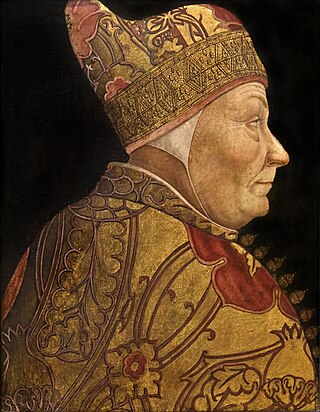
Lazzaro Bastiani was an Italian painter of the Renaissance, active mainly in Venice.

San Francesco della Vigna is a Roman Catholic church in the Sestiere of Castello in Venice, northern Italy.

The Madonna dell'Orto is a church in Venice, Italy, in the sestiere of Cannaregio. This was the home parish of Tintoretto and holds a number of his works as well as his tomb.

San Giovanni Grisostomo is a small church in the sestiere or neighborhood of Cannaregio, Venice.

The Scuola Grande di San Giovanni Evangelista is a confraternity building located in the San Polo sestiere of the Italian city of Venice. Founded in the 13th century by a group of flagellants it was later to become one of the five Scuole Grandi of Venice. These organisations provided a variety of charitable functions in the city as well as becoming patrons of the arts. The Scuola Grande di San Giovanni Evangelista is notable for housing a relic of the true cross and for the series of paintings it commissioned from a number of famous Venetian artists depicting Miracles of the Holy Cross. No longer in the school, these came into public ownership during the Napoleonic era and are now housed in the Gallerie dell'Accademia. The scuola is open to visitors on a limited number of days, detailed on the official website.
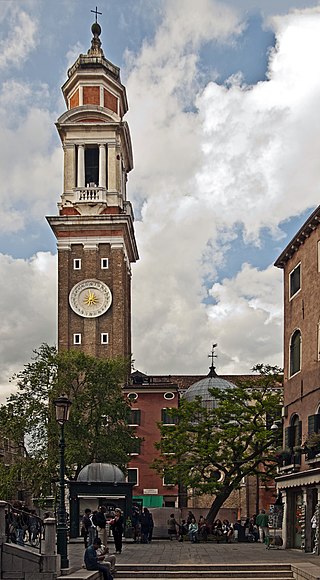
The Chiesa dei Santi Apostoli di Cristo, commonly called San Apostoli, is a 7th-century Roman Catholic church located in the Cannaregio sestiere of the Italian city of Venice. It is one of the oldest churches in the city and has undergone numerous changes since its foundation. The present building is the result of a major reconstruction project which was undertaken in 1575. The church is notable particularly for the Cornaro Chapel, an important example of Early Renaissance architecture, added by Mauro Codussi during the 1490s. The chapel is the burial place of several members of the powerful Cornaro family, including Catherine Cornaro, Queen of Cyprus and Armenia. The church houses several works of art including pieces by Giambattista Tiepolo and Paolo Veronese.

The San Giobbe Altarpiece is a c. 1487 altarpiece in oils on panel by the Venetian Renaissance painter Giovanni Bellini. Inspired by a plague outbreak in 1485, this sacra conversazione painting is unique in that it was designed in situ with the surrounding architecture of the church, and was one of the largest sacra conversazione paintings at the time. Although it was originally located in the Church of San Giobbe, Venice, it is now in the Gallerie dell'Accademia in Venice after having been stolen by Napoleon Bonaparte.

San Vidal is a former church, and now an event and concert hall located at one end of the Campo Santo Stefano in the Sestiere of San Marco, where it leads into the campiello San Vidal, and from there to the Ponte dell'Accademia that spans the Grand Canal and connects to the Sestiere of Dorsoduro, Venice, Italy.

San Lio is a church located on the campo of the same name in the sestiere of Castello.

The Pesaro Altarpiece is an oil-on-panel painting by the Italian artist Giovanni Bellini, dated to some time between 1471 and 1483. It is considered one of Bellini's first mature works, though there are doubts on its dating and on who commissioned it. The work's technique is not only an early use of oils but also of blue smalt, a by-product of the glass industry. It had already been used in the Low Countries in Bouts' 1455 The Entombment, but this marked smalt's first use in Italian art, twenty years before Leonardo da Vinci used it in Ludovico il Moro's apartments in Milan in 1492. Bellini also uses the more traditional lapis lazuli and azurite for other blues in the work.
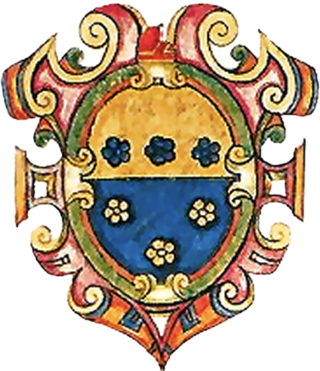
The House of Loredan-Santo Stefano was a cadet branch of the House of Loredan that existed from the 14th century until 1767. The branch was mainly settled in the Palazzo Loredan in Campo Santo Stefano, which they acquired in 1536 from the Mocenigo family. The progenitor of the branch is considered to be Gerolamo Loredan "dal Barbaro" di S. Vitale (d.~1474), father of Doge Leonardo Loredan and Dogaressa Caterina Loredan. Besides Leonardo, the branch also gave Doge Francesco Loredan.

